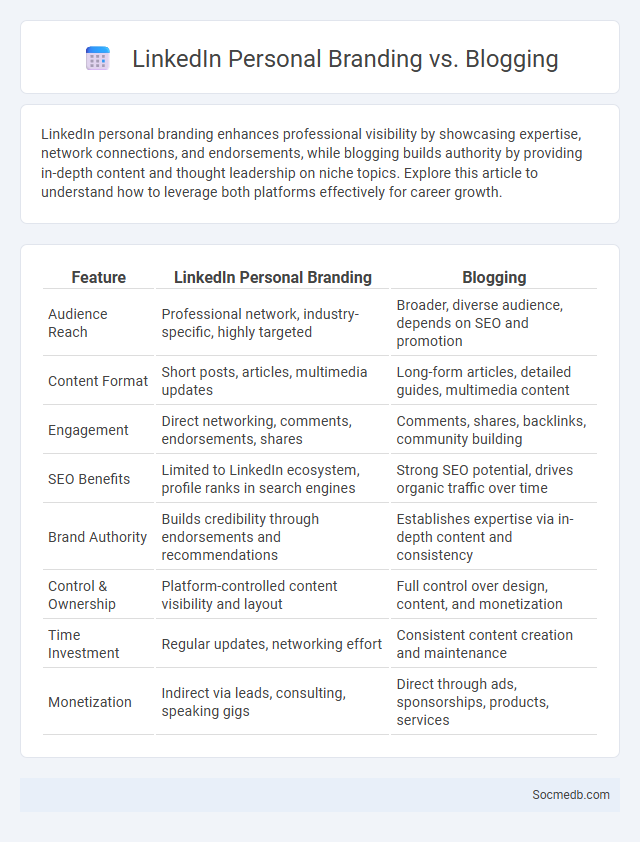
Photo illustration: LinkedIn Personal Branding vs Blogging
LinkedIn personal branding enhances professional visibility by showcasing expertise, network connections, and endorsements, while blogging builds authority by providing in-depth content and thought leadership on niche topics. Explore this article to understand how to leverage both platforms effectively for career growth.
Table of Comparison
| Feature | LinkedIn Personal Branding | Blogging |
|---|---|---|
| Audience Reach | Professional network, industry-specific, highly targeted | Broader, diverse audience, depends on SEO and promotion |
| Content Format | Short posts, articles, multimedia updates | Long-form articles, detailed guides, multimedia content |
| Engagement | Direct networking, comments, endorsements, shares | Comments, shares, backlinks, community building |
| SEO Benefits | Limited to LinkedIn ecosystem, profile ranks in search engines | Strong SEO potential, drives organic traffic over time |
| Brand Authority | Builds credibility through endorsements and recommendations | Establishes expertise via in-depth content and consistency |
| Control & Ownership | Platform-controlled content visibility and layout | Full control over design, content, and monetization |
| Time Investment | Regular updates, networking effort | Consistent content creation and maintenance |
| Monetization | Indirect via leads, consulting, speaking gigs | Direct through ads, sponsorships, products, services |
Introduction to Digital Personal Branding
Digital personal branding leverages social media platforms like LinkedIn, Instagram, and Twitter to establish and amplify individual identity and expertise. Crafting a consistent online presence through targeted content, strategic networking, and engagement enhances visibility and credibility in competitive digital landscapes. An optimized personal brand fosters professional opportunities, trust, and authority within specific niches or industries.
Understanding LinkedIn Personal Branding
Building a strong LinkedIn personal brand involves consistently showcasing your professional skills, experiences, and unique value proposition to attract opportunities and connections. You must optimize your profile with relevant keywords, compelling headlines, and engaging content that resonates with your target audience in your industry. Leveraging LinkedIn's features, such as recommendations and endorsements, helps you establish credibility and trust among peers and potential employers.
The Power of Blogging for Personal Branding
Blogging serves as a powerful tool for personal branding by allowing you to showcase your expertise, share your unique voice, and build a loyal audience around your niche. Consistently publishing high-quality, value-driven content enhances your online visibility and strengthens your credibility across social media platforms. Leveraging SEO strategies within your blog posts ensures that your personal brand attracts organic traffic and stands out in a crowded digital landscape.
Traditional Personal Branding: Beyond Digital Platforms
Traditional personal branding relies on consistent offline interactions, such as networking events, public speaking, and printed marketing materials, to establish a professional reputation. It emphasizes authentic communication, face-to-face relationships, and physical presence that digital platforms cannot fully replicate. Building trust and recognition through direct human engagement remains a powerful complement to social media strategies in today's interconnected world.
Key Differences: LinkedIn vs Blogging vs Personal Branding
LinkedIn primarily functions as a professional networking platform, emphasizing industry connections and job opportunities, while blogging offers more content control and depth for sharing expertise or personal narratives. Personal branding integrates both LinkedIn and blogging by strategically shaping one's reputation and visibility across multiple channels. The key difference lies in LinkedIn's structured environment for career-building, blogging's flexibility for creative expression, and personal branding's holistic approach to managing online identity.
Pros and Cons of LinkedIn Personal Branding
LinkedIn personal branding enhances professional visibility, enabling users to showcase expertise, network with industry leaders, and attract career opportunities. However, overemphasis on self-promotion can appear insincere, and maintaining an active, engaging profile requires significant time and effort. Privacy concerns also arise as personal information is publicly accessible, potentially affecting reputation if not managed carefully.
Pros and Cons of Blogging for Personal Branding
Blogging for personal branding enhances online visibility by showcasing expertise and building credibility through consistent, high-quality content. It facilitates genuine audience engagement and networking opportunities but requires significant time investment and content management skills. Challenges include maintaining relevance amid rapidly changing digital trends and navigating potential negative feedback or privacy concerns.
Integrating LinkedIn, Blogging, and Personal Branding Strategies
Integrating LinkedIn, blogging, and personal branding strategies creates a cohesive online presence that enhances professional credibility and visibility. By consistently sharing expert insights on LinkedIn and your blog, you establish authority within your niche while expanding your network. Your strategic use of personal branding aligns your messaging across platforms, ensuring that potential clients and employers recognize your unique value.
Choosing the Right Platform for Your Personal Brand
Choosing the right social media platform for your personal brand depends on where your target audience is most active and engaged. Platforms like LinkedIn are ideal for professional networking and personal branding in corporate environments, while Instagram and TikTok excel in visual storytelling and influencer marketing. Understanding each platform's unique features and user demographics ensures your content reaches the right people effectively.
Conclusion: Building a Cohesive Personal Brand Online
Building a cohesive personal brand online requires consistent messaging, authentic content, and strategic engagement across all social media platforms. Your brand identity should clearly communicate your values, expertise, and unique personality to create a memorable impression on your audience. By aligning your visuals, tone, and interactions, you strengthen your online presence and foster trust with your followers.
 socmedb.com
socmedb.com